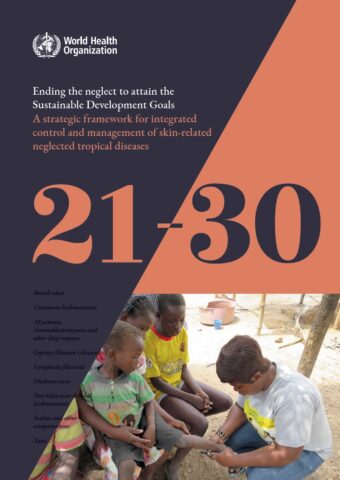
Launch of WHO Skin NTDs Strategic Framework
The WHO Skin NTDs Framework was launched this month. A companion document to the WHO NTDs Road map 2021-2030, the Framework centres on integrated approaches to the control and management of nine NTDs, including leprosy, that involve effects on the skin. From ILEP’s perspective, the logic is that people-centred, multi-disease approaches are a more efficient and effective way of ensuring people affected by leprosy obtain the services and supports that they need. These approaches are already demonstrated by joint programmes being implemented by ILEP members or partners in several countries.
WHO encourages countries to adapt the Framework to plan and implement integrated strategies based on the endemicity of Skin NTDs and other skin conditions. The potential areas for integration are very broad, ranging from prevention to case-finding, laboratory diagnostics, treatment, self-care, management of complications, rehabilitation, social inclusion and human rights, capacity building and training, surveillance and more. From the zero-leprosy perspective, this breadth of focus is important. ILEP’s vision is not only zero transmission of leprosy, but also zero disability and zero stigma and discrimination. Similarly, ILEP welcomes the focus on empowering persons affected by skin NTDs and their family members, giving them greater participation in decisions and actions that affect their health and all aspects of their wellbeing.
ILEP members were well-represented on the Framework’s review panel and in providing written input into the consultation drafts. At the launch event on 8th June, ILEP was invited to speak about integration with other skin NTDs on the path to zero leprosy. Representing ILEP, Geoff Warne (CEO) commented that an integrated approach is effective where there are commonalities between diseases and where there are recognisable advantages for each disease.
Four of the ways integration can help towards zero leprosy seem especially promising:
- Joint programs for active case detection and for contact tracing
- Detailed integrated mapping using some of the advanced mapping tools available
- The whole group of essential services around the management of disease complications, disability prevention and social inclusion
- Joint approaches to capacity development and training
But ILEP also recognises that integration carries with it some risks for leprosy.
- The risk of erosion of leprosy expertise. This especially important given that leprosy can be a difficult disease to diagnose and manage
- The risk of overloading health workers, so that leprosy – which they may not see very often – gets forgotten again
- The risk that leprosy is regarded only as a skin disease, so that the importance of nerve function assessment for accurate diagnosis and treatment is completely forgotten, and the need for instruction in disability prevention is neglected or overlooked
- The risk of loss of focus for donors and partners committed to leprosy
WHO advises countries to think carefully about the potential for integration in their particular context, and how integrated approaches might provide opportunities to mobilise, share and pool resources. ILEP’s perspective is that countries planning integrated approaches need to do so in a thoughtful way that analyses what the gains will be and how the downsides or risks can be reduced or avoided. ILEP members should expect to be called upon to support such planning processes in endemic countries.